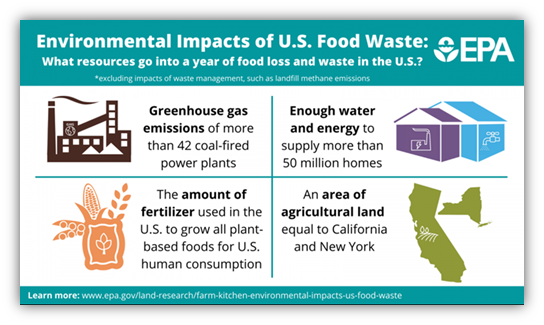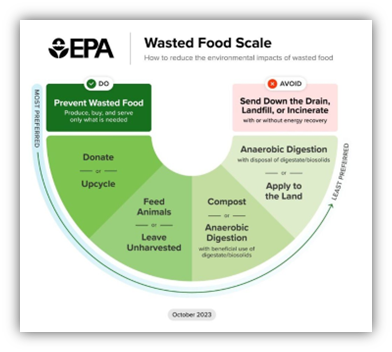Written by Micaela Griffin, P3 Specialist Published on November 17, 2023
With the holidays quickly approaching, we have some delicious meals to look forward to, not to mention all of the leftovers and extra ingredients. Throughout the year, we might find ourselves accidentally buying or preparing more food than we can enjoy before it spoils. According to Feeding America, approximately 119 billion pounds of food goes to waste each year in the U.S., equating to about 130 billion meals that could have gone to people facing hunger. That’s more than 1/3 of food in the U.S. that goes uneaten and about 37% of that food waste occurs in our own homes.
Environmental and Economic Impact

Wasting food means also wasting the resources used to produce it, process it, and so on. When thrown in the trash, food ends up in landfills where methane, a greenhouse gas, is emitted as the food decomposes. In fact, food decomposition is responsible for an estimated 58% of the total methane emissions from municipal solid landfills. This is a significant contribution given that food waste only accounts for approximately 24% of landfill waste. Disposing of food waste in sink drains and in garbage disposals can cause backups in your home and can lead to costly repairs. Blockages in the sanitary sewer system, especially those caused by fats, oils, and grease (FOG), can lead to sanitary sewer overflows (SSOs). The raw sewage that is released during an SSO proposes a threat to public health and can contaminate our waterways. Doing your part to minimize food waste not only reduces your carbon footprint but also puts money back into your pockets. According to the U.S. Department of Agriculture, the average family of four spends $1,500 per year on food that does not get eaten.
What Can We Do to Reduce Food Waste at Home?
- Only purchase what you need. Take a quick inventory of your kitchen to see what items you already have. Make a grocery list to stay on track while shopping.
- Properly store leftovers and excess ingredients. Freeze, pickle, can, or dehydrate foods to use at a later date. Know which produce items should be stored in the fridge vs. on the counter.
- Enjoy your leftovers! Keep your fridge and freezer organized so you can easily find what you’re looking for. Date the items so you know what needs to be eaten first.
- Know the difference between “Use By” and “Best Buy” dates. Most products when stored properly are safe to eat beyond the provided “Best Buy” date.
- Use online resources, such as the SuperCook app, to find recipes for the items you already have on hand.
- Donate safe perishable and non-perishable items that you don’t need or want to a local food bank or pantry. You can also join a local “Buy Nothing” Facebook group, where you can give away items you no longer need or ask for items someone else may have in excess, free of charge. This is a great way to directly help your neighbors while reducing waste.
- Compost food scraps, either at home or at your local compost center. Food has valuable nutrients that we shouldn’t let go to waste!

The EPA has developed the Food: Too Good to Waste Challenge to help consumers determine how much food is going to waste in their homes and how they can reduce food waste moving forward. Will you take the challenge and help tackle food waste in your home.
Helpful resources:
https://www.feedingamerica.org/our-work/reduce-food-waste
https://www.usda.gov/foodwaste/faqs
https://www.epa.gov/recycle/preventing-wasted-food-home
https://www.usda.gov/foodlossandwaste/consumers
https://www.epa.gov/sustainable-management-food/wasted-food-scale
https://www.epa.gov/recycle/preventing-wasted-food-home
https://www.epa.gov/land-research/quantifying-methane-emissions-landfilled-food-waste
Contributed by Micaela Griffin, P3 Specialist